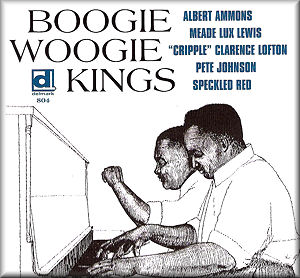Albert Ammons
1. Pinetop’s Blues
Pete Johnson
2. G-Flat Blues
“Cripple” Clarence Lofton
3. Streamline Train
4. Pitchin’ Boogie
5. Mistaken Blues
6. Travelin’ Blues
7. I Don’t Know
8. Mercy Blues
Meade Lux Lewis
9. Doll House Boogie
10. Whistlin’ Blues
Henry Brown
11. Deep Morgan
12. 22nd St. Stomp
13. Pickin’ Em Out Again
Speckled Red
14. Dirty Dozens
15. Dad’s Piece
16. Pinetop’s Boogie Woogie
17. Right String But The Wrong Yo Yo
Albert Ammons, Pete Johnson & Meade Lux Lewis
18. Boogie Woogie Prayer
Meade Lux Lewis
19. Closing Time
Delmark has acquired some recordings originally made for the Euphonic
Sounds label and this album contains the cream of their boogie woogie
tracks by the best-known masters of the genre. Many of the tracks
were recorded in 1939 at the Sherman Hotel in Chicago by the famous
trio of Albert Ammons, Meade Lux Lewis and Pete Johnson. These tracks
are interspersed with others made later by such pianists as Speckled
Red and "Cripple" Clarence Lofton.
The result is a CD that encapsulates the boogie woogie style at its
best. Every pianist delivers that agile left-hand rhythm as the basis
for right-hand improvisations. The beat is infectious right from the
start, as Albert Ammons launches into the boogie classic Pinetop's
Blues. You might expect a whole album of boogie woogie to be repetitive
but the left-hand rhythms display a remarkable variety of techniques.
Some players use the conventional boogie up-and-down sequence while
others employ chords or single notes to drive the music along.
The word "blue" in several of the titles betrays the other
strong influence in this music, since many performances are typical
blues tunes, sometimes with bluesy vocals attached - like Clarence
Lofton's Mistaken Blues. And a piece like Lofton's Streamline
Train suggests where Humphrey Lyttelton may have found the rhythm
for his hit Bad Penny Blues.
The style of Meade Lux Lewis is markedly different, with him whistling
on Whistlin' Blues and switching from piano to tinkling celeste
halfway through Doll House Blues. Recorded in 1960, Henry Brown
seems to have been lumbered with a tinny piano but his sturdy playing
comes through against the odds. Deep Morgan includes a fairly
incomprehensible spoken commentary.
Speckled Red's contributions are rather clangorous, as he seems to
like using the sustain pedal a lot. However, Pinetop's Boogie Woogie
is an enduring piece of melodrama, with its continual cliff-hanging
pauses filled by echoey clangour from the piano.
The trio performance of Boogie Woogie Prayer by Ammons, Johnson
& Lewis is one of the album's highspots, setting up a rich and
deep profusion of sounds as the three instrumentalists band together
to whack seven bells out of their pianos. The CD ends with Meade Lux
Lewis emphasising the bass in his interpretation of his own composition,
Closing Time.
All but five of the 19 tracks on this album have been released before,
so boogie woogie fans may find it duplicates parts of their existing
collections, but the CD would make a valuable introduction to this
arcane art for any newcomers.
Tony Augarde
